Having problems registering on Coin Return? Please email support@coin-return.org, and include your PA username and PIN.
Spirited [Anime]
italianranma Registered User regular
Registered User regular
 Registered User regular
Registered User regular
Sorry, (I'm not sorry) I'm going to chat about the objectively best isekai Spirited Away more.
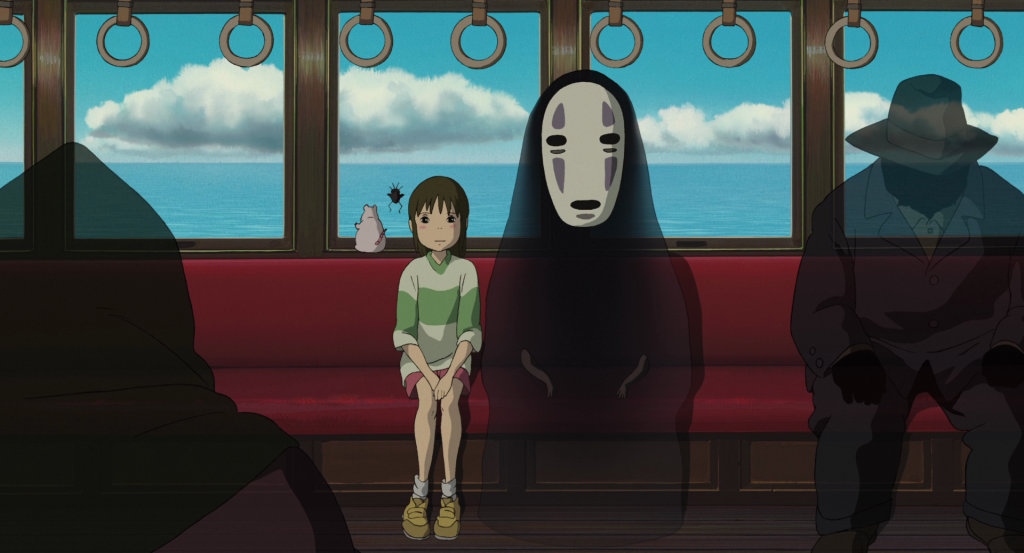
I was lucky enough to watch it in theaters in America. What struck me at first about it was just how much stuff is in it. Why do all the female bath house employees have the high painted on eyebrows popular in the Edo era? Was there some significance in the fact that it's a radish spirit who shares the elevator with Chihiro? Why is 油 (oil) so prominent on the bathhouse merch? I was dating a Japanese girl at the time and really grilled her on all these cultural things that I had no experience with because I so desperately wanted to understand everything about this film. Spirited Away by far is Miyazaki's movie with the highest density of symbolism, but I've learned over the years that not everything shown is symbolic or even significant. And I think the train scene embodies this best:
 https://youtu.be/VbRmFSQYeac
https://youtu.be/VbRmFSQYeac
(For listening: Joe Hisaishi The Sixth Station)
This is my favorite scene in the movie, and I can't understand exactly why that is. I get a similar feeling of melancholy from the underwater Hyrule scene in The Windwaker and exploring the outskirts of Hyrule in Breath of the Wild. Your Name also does this to a certain extent, but because the cause of sadness (loss of one's significant other) is known, it can't be properly described as melancholy. There's one additional experience that I'm always reminded of: back in 2005 I fled east from Hurricane Katrina to Jacksonville Florida, and on the way back home on Highway 10 I saw more than a few streets that were completely submerged in water in a very similar way to how the train tracks are shown in Spirited Away. After watching the movie again I decided to do a little more digging to see if there was more symbolism in that scene that I was missing out on.
I said it indirectly in my last post about it, but in many ways Spirited Away is a huge thematic departure from Miyazaki's previous works which focus primarily on achieving a balance between human achievement and harmony with nature. He said in an interview;
Thematically Spirited Away is all about retaining one's identity even as one must adapt to the changing demands of the world, and specifically about doing so through adolescence. I think this is pretty well known, so I'm going to focus on that train scene because there's an elusive quality of it that relates to this theme. And for those who haven't seen it yet spoilers below:
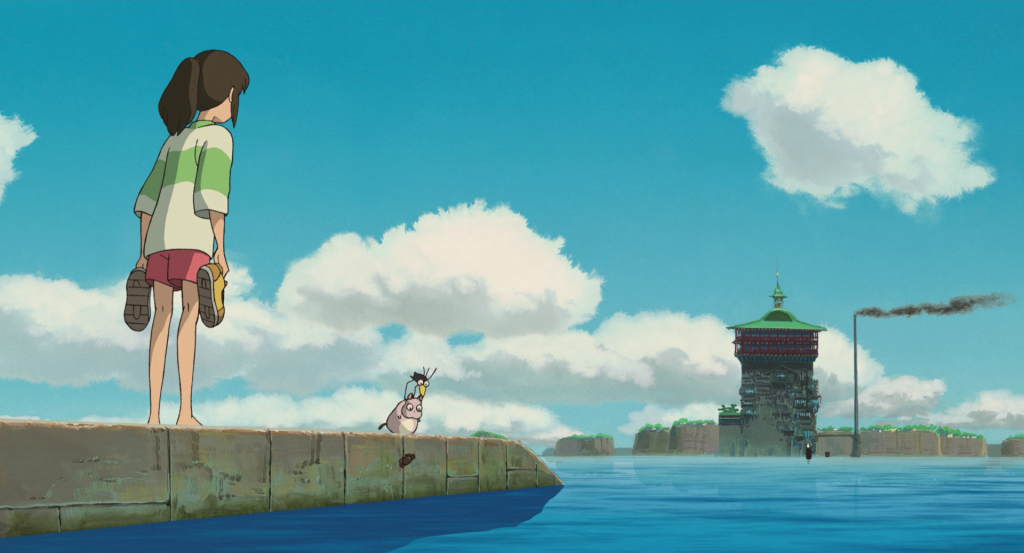
Going into this scene we've got a few things to review: we've just finished the climax of the movie: Chihiro has through her own power rescued Haku from death, absolved Noh-Face of greed, and in doing so saved Yubaba's bathhouse from destruction. She then embarks on her next selfless act which is to return Zeniba's hanko; a hanko is a personal seal used in Japan and constitutes your signature on legally binding documents. It is extremely symbolic of one's identity, and its abduction could be seen as a kind of identity theft. To even further understand the significance of this act in Japanese culture, Chihiro is accepting the Giri (a word that can be translated as debt, but has much deeper cultural significance) of Haku's theft in order to clear his name. Her belief that Haku is not a thief and the desire to make that true overrides her indebtedness even to her parents who are still pigs. This is implicitly stated by Kamaji as he points out that tickets are extremely rare and that the train only runs in one direction. It is in this scene that Chihiro has made her first decision completely independently of others that isn't driven by necessity or circumstance.
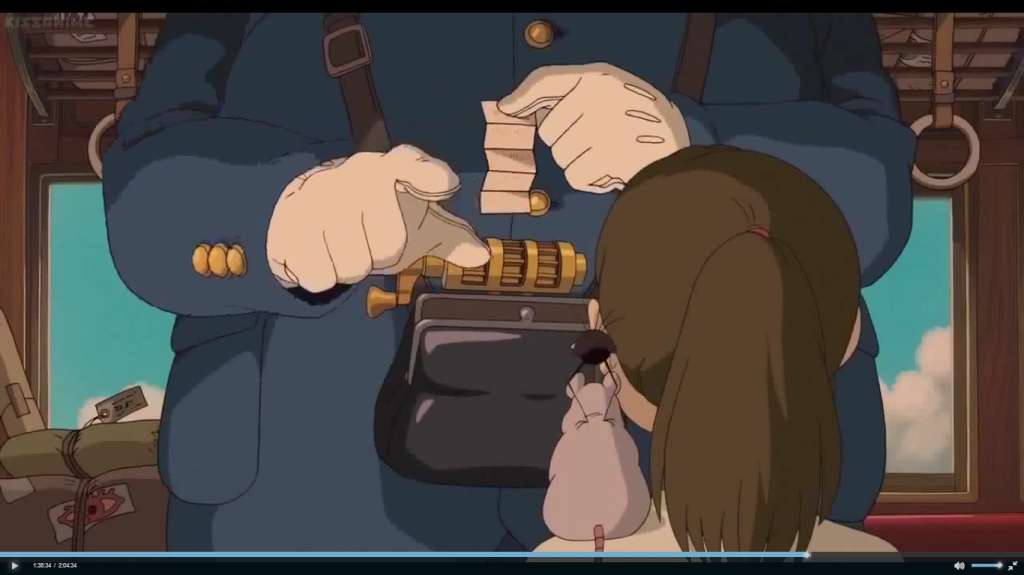
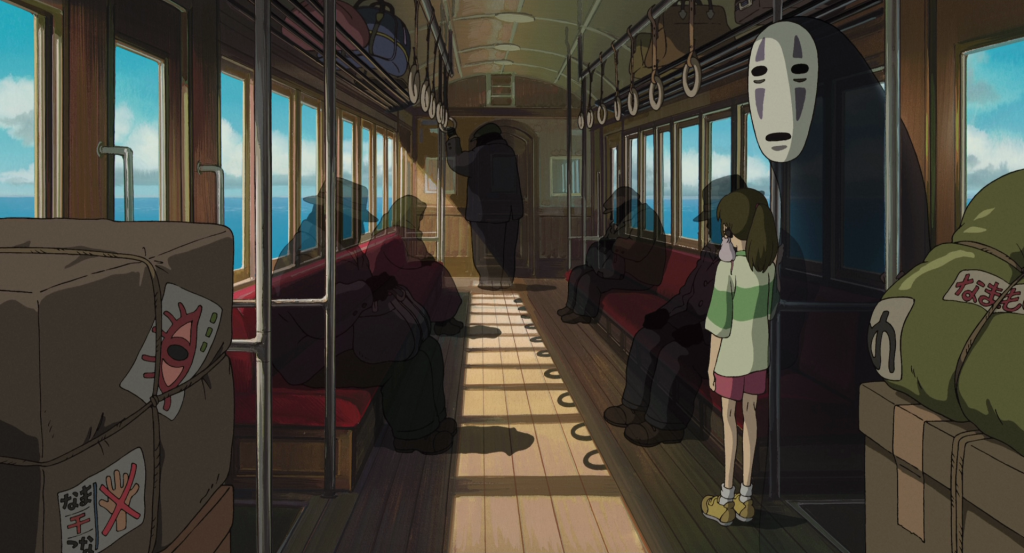
On the train itself we see the large imposing figure of the conductor who silently and oppressively shreds her tickets as she boards the train. All the other figures here are shadowy, but unmistakably adults. Boh and the transformed bird hop excitedly at the prospect of being on a trip while Chihiro takes her place on the train stoically staring forwards, not looking back.
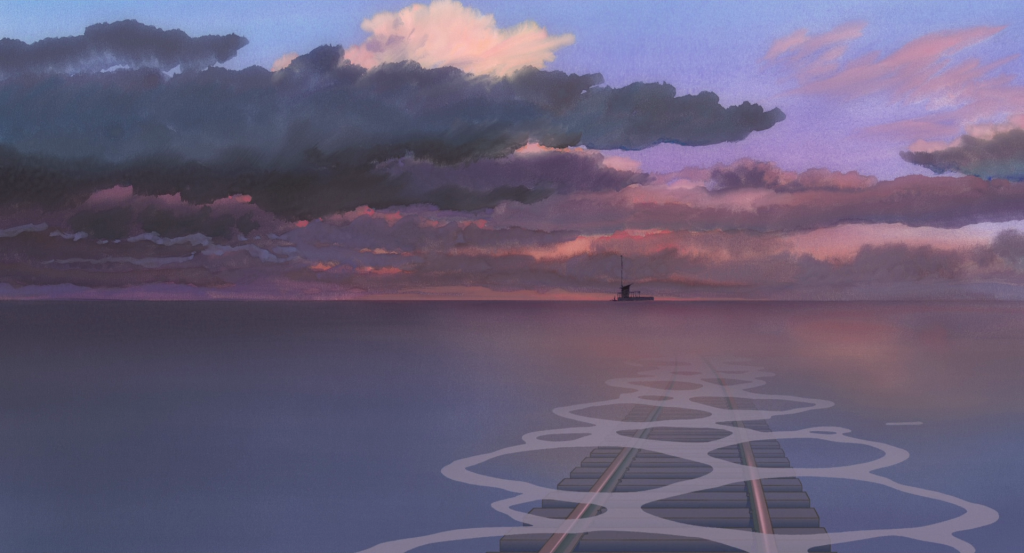
The scene is heavy with metaphor: this one-way journey for Chihiro is the adolescent's journey to adulthood. The shadowy figures on the train are the random disassociated strangers of adult life. The isolated landscapes separated by oceans those places we inhabit in our humdrum routine: home, work, the trainstops between them. The shadowy girl who looks to be Chihiro's age is her own self as a child, left behind in this transition.
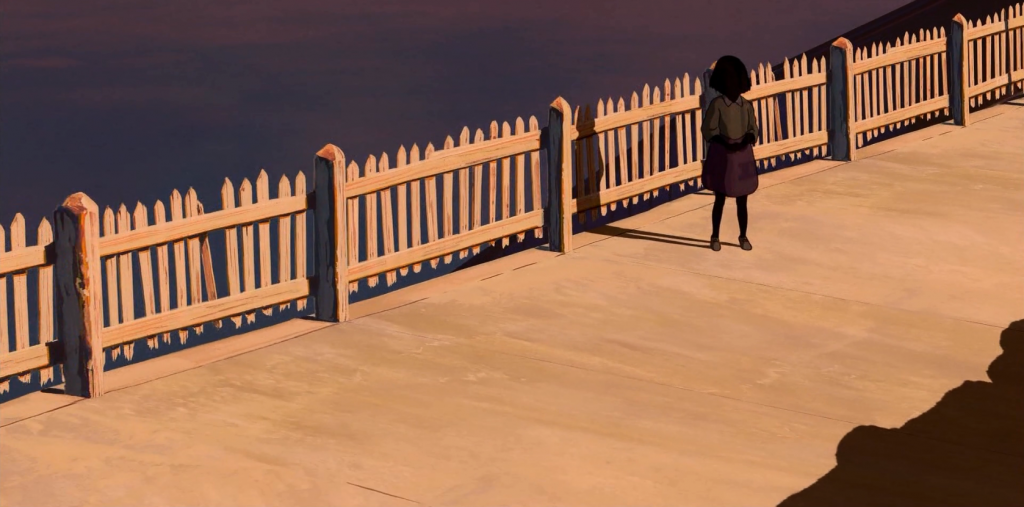
The scene is heavy with something else, and this is what I couldn't quite put my finger on until I did the research behind it. Artists call it negative space, but the Japanese word for it is 間 (ma). When Roger Ebert told Miyazaki how he loved how motion is expressed in his movies he said, “...Instead of every movement being dictated by the story, sometimes people will just sit for a moment, or they will sigh, or look in a running stream, or do something extra. Not to advance the story, but only to give the sense of time and place and who they are.”
After Chihiro finds her place on the train and motions for Noh-face to sit beside her there is not a single word of dialogue spoken, or any action on her part (aside from looking forlorn out the window) for the next 2 minutes, not until she disembarks at Zeniba’s house. But this still speaks volumes about her character: she has gone from being a child, lounging in the back seat of her parents’ car, to being an adult taking responsibility for the three charges under her care. The carefree idleness of youth replaced by the anxious ambivalence of adulthood. I can’t take credit for this line, but it’s beautiful and I have to share it:

Of course Miyazaki isn’t the only director to use Ma & metaphor to capture the audience’s emotions. What other anime has spirited you away?

I was lucky enough to watch it in theaters in America. What struck me at first about it was just how much stuff is in it. Why do all the female bath house employees have the high painted on eyebrows popular in the Edo era? Was there some significance in the fact that it's a radish spirit who shares the elevator with Chihiro? Why is 油 (oil) so prominent on the bathhouse merch? I was dating a Japanese girl at the time and really grilled her on all these cultural things that I had no experience with because I so desperately wanted to understand everything about this film. Spirited Away by far is Miyazaki's movie with the highest density of symbolism, but I've learned over the years that not everything shown is symbolic or even significant. And I think the train scene embodies this best:
 https://youtu.be/VbRmFSQYeac
https://youtu.be/VbRmFSQYeac(For listening: Joe Hisaishi The Sixth Station)
This is my favorite scene in the movie, and I can't understand exactly why that is. I get a similar feeling of melancholy from the underwater Hyrule scene in The Windwaker and exploring the outskirts of Hyrule in Breath of the Wild. Your Name also does this to a certain extent, but because the cause of sadness (loss of one's significant other) is known, it can't be properly described as melancholy. There's one additional experience that I'm always reminded of: back in 2005 I fled east from Hurricane Katrina to Jacksonville Florida, and on the way back home on Highway 10 I saw more than a few streets that were completely submerged in water in a very similar way to how the train tracks are shown in Spirited Away. After watching the movie again I decided to do a little more digging to see if there was more symbolism in that scene that I was missing out on.
I said it indirectly in my last post about it, but in many ways Spirited Away is a huge thematic departure from Miyazaki's previous works which focus primarily on achieving a balance between human achievement and harmony with nature. He said in an interview;
Miyazaki-sensei wrote:This movie is a story about a 10-year-old whose father and mother happened to eat something they shouldn't have, and so became pigs. The movie appears to be satire, but that isn't my purpose. I have five young female friends who are about the same age as Hiiragi-san*, and I spend every summer with them at my mountain cabin. I wanted to make a movie they could enjoy. That is why I started this film, and that is my true purpose.
*HIIRAGI Rumi, the 13-year-old voice actress of Chihiro. She was at the press conference during which this interview took place.
We have made "Totoro," which was for small children, "Laputa," in which a boy sets out on a journey, and "Kiki's Delivery Service," in which a teenager has to live with herself. We have not made a film for 10-year-old girls, who are in the first stage of their adolescence. So, I read the shoujo manga such as Nakayoshi or Ribon which they left at my mountain cabin.
I felt this country only offered such things as crushes and romance to 10-year-old girls, though, and looking at my young friends, I felt this was not what they held dear in their hearts, not what they wanted. And so I wondered if I could make a movie in which they could be heroines...
If they find this movie to be exciting, it will be a success in my mind. They can't lie. Until now, I made "I wish there was such a person" leading characters. This time, however, I created a heroine who is an ordinary girl, someone with whom the audience can sympathize, someone about whom they can say, "Yes, it's like that." It's very important to make it plain and unexaggerated. Starting with that, it's not a story in which the characters grow up, but a story in which they draw on something already inside them, brought out by the particular circumstances... I wanted to tell such a story in this movie. I want my young friends to live like that, and I think they, too, have such a wish.
Thematically Spirited Away is all about retaining one's identity even as one must adapt to the changing demands of the world, and specifically about doing so through adolescence. I think this is pretty well known, so I'm going to focus on that train scene because there's an elusive quality of it that relates to this theme. And for those who haven't seen it yet spoilers below:

Going into this scene we've got a few things to review: we've just finished the climax of the movie: Chihiro has through her own power rescued Haku from death, absolved Noh-Face of greed, and in doing so saved Yubaba's bathhouse from destruction. She then embarks on her next selfless act which is to return Zeniba's hanko; a hanko is a personal seal used in Japan and constitutes your signature on legally binding documents. It is extremely symbolic of one's identity, and its abduction could be seen as a kind of identity theft. To even further understand the significance of this act in Japanese culture, Chihiro is accepting the Giri (a word that can be translated as debt, but has much deeper cultural significance) of Haku's theft in order to clear his name. Her belief that Haku is not a thief and the desire to make that true overrides her indebtedness even to her parents who are still pigs. This is implicitly stated by Kamaji as he points out that tickets are extremely rare and that the train only runs in one direction. It is in this scene that Chihiro has made her first decision completely independently of others that isn't driven by necessity or circumstance.


On the train itself we see the large imposing figure of the conductor who silently and oppressively shreds her tickets as she boards the train. All the other figures here are shadowy, but unmistakably adults. Boh and the transformed bird hop excitedly at the prospect of being on a trip while Chihiro takes her place on the train stoically staring forwards, not looking back.

The scene is heavy with metaphor: this one-way journey for Chihiro is the adolescent's journey to adulthood. The shadowy figures on the train are the random disassociated strangers of adult life. The isolated landscapes separated by oceans those places we inhabit in our humdrum routine: home, work, the trainstops between them. The shadowy girl who looks to be Chihiro's age is her own self as a child, left behind in this transition.

The scene is heavy with something else, and this is what I couldn't quite put my finger on until I did the research behind it. Artists call it negative space, but the Japanese word for it is 間 (ma). When Roger Ebert told Miyazaki how he loved how motion is expressed in his movies he said, “...Instead of every movement being dictated by the story, sometimes people will just sit for a moment, or they will sigh, or look in a running stream, or do something extra. Not to advance the story, but only to give the sense of time and place and who they are.”
Miyazaki-sensei wrote:We have a word for that in Japanese, it’s called ‘Ma’. Emptiness. It’s there intentionally...he claps his hands three or four timesThe time in between my clapping is Ma. If you just had non-sto action with no breathing space at all, it’s just busyness. But if you take a moment, then the tension building in the film can grow into a wider dimension. If you just have constant tension at 80 degrees all the time you just get numb.
The people who make movies are scared of silence, so they want to paper and plaster it over. They’re worried that the audience will get bored. They might go up and get some popcorn. But just because it’s 80% intense all the time doesn’t mean the kids are going to bless you with their concentration. What really matters is the underlying emotions - that you never let go of those.
What my friends and I have been trying to do since the 1970s is to try an quiet things down a little bit; don’t just bombard them with noise and distraction. And to follow the path of children’s emotions and feelings as we make a film. If you stay true to joy and astonishment and empathy you don’t have to have violence and you don’t have to have action. They’ll follow you. This is our principle.
After Chihiro finds her place on the train and motions for Noh-face to sit beside her there is not a single word of dialogue spoken, or any action on her part (aside from looking forlorn out the window) for the next 2 minutes, not until she disembarks at Zeniba’s house. But this still speaks volumes about her character: she has gone from being a child, lounging in the back seat of her parents’ car, to being an adult taking responsibility for the three charges under her care. The carefree idleness of youth replaced by the anxious ambivalence of adulthood. I can’t take credit for this line, but it’s beautiful and I have to share it:
Christopher Runyon wrote:If My Neighbor Totoro is Miyazaki’s celebration of childhood, then Spirited Away‘s single train scene is a requiem: the ultimate depiction of a sad, lonely adult life devoid of joy and laughter. It is the death of youthful innocence; the sunset signaling the start of a long, dark night. Had it not been for Grave of the Fireflies, this single scene would have been the most grim and beautifully depressing thing to ever come out of the Studio–and it’s certainly the most grim and depressing to ever come out of Miyazaki.

Of course Miyazaki isn’t the only director to use Ma & metaphor to capture the audience’s emotions. What other anime has spirited you away?
飛べねぇ豚はただの豚だ。
Chairman Meow on
+16
This discussion has been closed.

Posts
Carrot, Duke Dogstorm, and The Three Dogstorm Musketeers are cool though
Steam Switch FC: 2799-7909-4852
I dont think its really been viewable yet
Jadeite just started yelling some ultra misogynist things and the scouts fucking murdered him. I'd like to hope this show instilled those values in me when I was young and impressionable.
I'm thinking Umineko no Naku Koro Ni, for turning a visual novel that consumed my life for a while into an awful anime only notable for its cast and memes.
Thinking on it more. Two entire categories of bad adaptation come to mind.
Any of those anime where they adapted a yuri or yaoi series but reduced text to subtext or stuffed in a male protagonist, which was happening a lot a few years ago for no reason I can understand. Akuma no Riddle is a particularly bad example of this, since it was a near-panel-for-panel adaptation with the extremely obvious exception of romantic scenes or lines.
Incoherent ultra-compressed single-season advertisements for light novels/manga/games can be pretty bad too.
Compressed too much into too little time, basically. And lots of wrong or changed details that add up to problems for the mystery component of the thing.
i can't recommend it to anyone
Steam Switch FC: 2799-7909-4852
Three full length, decent budget movies, just dedicated to the Golden Age arc, it really should've been dope. But their focus was all wrong, they included almost every single battle sequence from the manga (using kinda ugly, PS3-cutscene looking CG to be able to afford to animate all those battles), while excising a lot of the quiet character moments that actually matter to the story. Like the battles matter, sure, but you can mostly early-Game-of-Thrones them, just show them starting and then cut to the end. Yeah, Guts killed a bunch of dudes, again, we know. It's Guts, that's the thing he does.
They're not like, actively -bad-, but they're just so lacking in artistic vision, they're taking extremely good material and making it entirely mediocre.
maybe it's that i hold them in a little higher regard retroactively when stacked next to berserk '16
but their real saving grace was the banging soundtrack
I'm impressed by the dedication to telling this whole smooching incident in reverse. We already had follow-up from this 10 chapters ago!
Also his "wha..." always makes me chuckle.
Wud yoo laek to lern aboot meatz? Look here!
Why, you think it would have been a further embarassment? Or that a general audience may have handled certain revelations poorly?
Help
Should’ve gone for something easier than those shells.
Phantom Blood is good
but Battle Tendency has Joseph Joestar, the king of kings and maybe my favorite protagonist ever
Also all of the CG stuff looked like Paw Patrol toys.
I keep seeing fans abbreviate Conqueror's Haki/Color of Conqueror's to CoC
So folks will talk about Shank's powerful CoC or how we'll definitely see Zoro use CoC in wano
I can't stop laughing and apparently I'm 11
Steam Switch FC: 2799-7909-4852
yeah you know me
Steam Switch FC: 2799-7909-4852
This post is from a few weeks ago, but I just started reading this manga a few days ago and just got to this scene and was like "Hey, I've seen that somewhere before."
It's been an enjoyable read so far, but writing Raino out of the series was bullshit. Also I think the author forgot about the class rep character a long time ago (unless she returns in later chapters).
I think the thing that helps is that the main character is actually extremely aware of how creepy his power could be, and so he does everything he can to not take advantage of anyone.
I was actually surprised at how wholesome the series actually turned out. You know, except for all the violence and property destruction.
Is it slapstick violence, at least?
For the most part, though at one point a character has his fingers broken with a bottle cap opener, but it happens off-panel. That was probably the worst case, it's mostly people getting slammed into walls really hard and passing out instead of anyone getting maimed or anything. No gore aside from the occasional blood running down the forehead bit.
Also there's lot of bad language. Forgot to mention that.
Also plenty of threats.
Most of the anime is a prequel to the manga.
Well they are monthly chapters.
Going to spoiler my reply since it's getting later into the manga and a part I just got to.
However, I read the scene where Ranna had the beads placed on her differently. We were previously shown when Ling had the beads placed on her and turned good, she no longer had feelings for Rokudou. When Ranna goes catatonic with the beads, however, we are shown that she is dreaming about spending time with Rokudou, and as soon as he disappears from the dream she immediately wakes up and shatters the beads. That seems to show that she already loves Rokudou whether she's good or evil, but there's no way for the rest of the cast to know that yet.
Plus since day one it's been practically guaranteed that the series is ending with him losing his powers and making us think Ranna hates him only to pull a fakeout and show she still loves him. I'd almost put money on that.
Overall, there have been 8 main girls effected by his power (and a bunch of generic background ones with no real story). Tsubaki barely even acts like she was ever in love with him and is just a friend now. Same with Osanada. Azami rarely shows up and has an obvious love interest of her own now. Yashiya just seemed to be a villain so Rokudou would have someone to face as the party was battling their way up the tower to face the Shishio guy. Raino initially fell for him because of the magic but I think she's one that you could break the spell right now and she'd still love him (which is probably why she was the only one to be written out instead of getting to stay at the school). I've just finished the arcs with Minami and Ling so I'll need to see how it is once they fully integrate at the school.
That just leaves Ranna, whose personality seems to most wildly be effected by the magic. The generous read on that is because it's the first time she's ever been happy and this is just how she acts when allowed to be happy. After all, nobody else suffered a personality shift from the magic. We'll have to see how things are resolved to know if that's really the case though.
Relatedly, I am really surprised there are this many adults from the last series that are still alive and or uninjured. Guy is in wheelchair, because one of his legs no longer works, and Sasuke is missing an arm. This doesn't stop either of them in any way shape or form, which is amusing, but that's the worst that anybody has gotten in the extended cast. Even the two elders that were the squad members with the Third Hokage are still alive and being pains in the ass to everybody in Konoha.
There are 53 episodes before the movie, which I've heard is around the beginning of the manga?
The episode count is actually higher than 119 (and still ongoing), but like I said I'm catching up.
They also confirmed that Osanada hasn't been effected by the spell in a long time. Based on that you could probably debate about Azami since thrillseeking isn't inherently bad and she's not a vigilante anymore and is law-abiding aside from speeding. Though strangely they did confirm Tsubaki is still a considered bad (for vanity and bad temper I guess?) though she hasn't acted attracted to Rokudou in forever.
You can't take the joy of watching Himari suckerpunch Naruto with the Gentle Fist for a 1HKO away from me